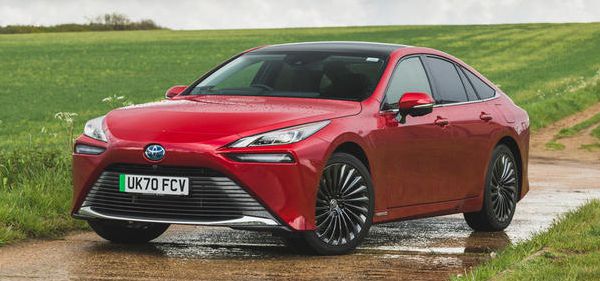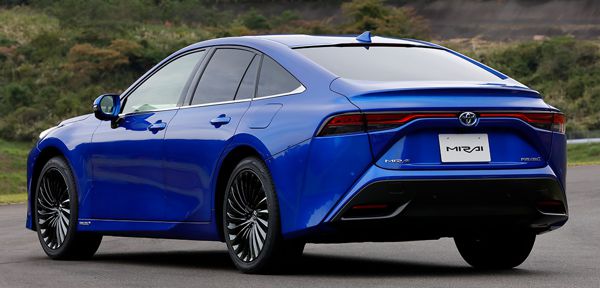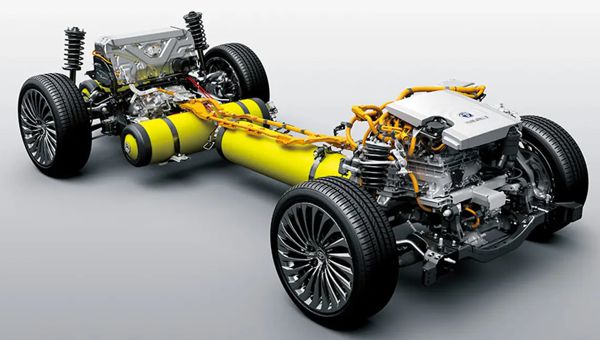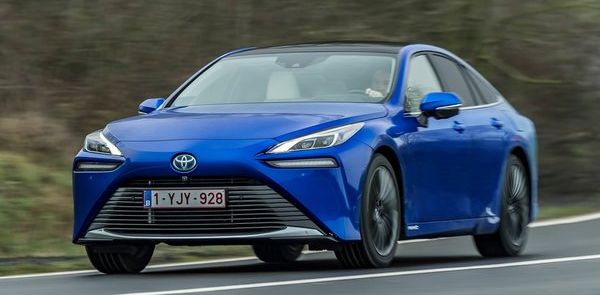Published
on 21
Sep 2021
|
All rights reserved.
|
|
|

|
|
While
there is some oddness in its long nose and big mouth, compared with the
Mk1 beast it is a beauty.
|
|
The
first generation Mirai had a lot of problems. We described it looked
like a pig, ran like a turtle, priced like a 7-Series but built like a
Prius. Cars could not be much worse than that. However, as the world’s
first attempt to mass produce hydrogen fuel cell cars, all these flaws
can be forgiven. Toyota knows it needs time and experience to move on
the technology, so instead of targeting return on investment right now,
it counts on the future. Keep committing resources into the program,
improving performance and reducing costs simultaneously, growing
economy of scale, and success will arrive eventually. If the experience
of Prius is indicative, then the second generation Mirai could arrive
the tipping point, and the next generation could be a commercial hit.
Toyota built 11,000 Mirais over the last 5 years. Most of them were
sold in Japan and California, while Europe shared a few hundreds. For
the second generation, Toyota aims at increasing capacity by more than
10 folds to 30,000 units a year. That will lift public awareness of the
hydrogen fuel cell technology, and likely to attract governments and
energy industries to build more refilling stations, something crucial
to the popularity of hydrogen cars.
From looks, you won’t believe this is the second generation Mirai. It
shares absolutely no genes with the outgoing car, except that 4 wheels
remain. Even then, these wheels are 3 inches larger and far more
stylish. Ditto the car itself. Long, low, wide and sleek, its body
shape is a sharp contrast to the original. While there is some oddness
in its long nose and big mouth, compared with the Mk1 beast it is a
beauty.

|
|
Incredibly,
the new Mirai is built on the GA-L platform from which Lexus LS and LC
are derived.
|
|
Enabling such a dramatic change is a new underpinning. While the last
car was derived from the Prius platform, the new one rides on GA-L
platform on which Lexus’ flagship LS limousine and LC luxury coupe are
built. When I heard this for the first time, I found it quite
unbelievable. However, think twice, and it appears more sensible than
it sounds. The rear-drive GA-L platform suits the Mirai very much. It
gives more space to pack the space-consuming hydrogen fuel tanks, fuel
cell stack, electric motor and battery pack while allowing good weight
distribution and low center of gravity, not to mention the improved
aesthetic. Meanwhile, production costs can be slashed by de-contenting:
while all-round multi-link suspensions are kept, the Mirai does without
air suspension and adaptive dampers. It just utilizes the basic
architecture of GA-L.
Advancement in fuel cell technology also helps improving the packaging.
The old car’s hydrogen fuel cell was pretty big and heavy. It could not
fit under the bonnet together with the electric motor, so Toyota placed
it under the front seats, which resulted in an elevated driving
position. The RWD new car has its electric motor moved to the rear
axle, freeing up the front engine compartment. Meanwhile, the new fuel
cell stack is made 20 percent smaller and 50 percent lighter than the
first generation, yet it produces 172 horsepower instead of
the previous 153 hp. Therefore, it can be moved to the engine
compartment. This move also enables Toyota to add another hydrogen fuel
tank inside the transmission tunnel. In addition to the other 2 tanks –
one located under the rear seat and another aft of the rear axle – the
new car can store 5.6kg of hydrogen at 10,000 psi, up from 5kg of the
old car, allowing a driving range of 400 miles, or 30 percent longer
than the old car. That gives the car a strong advantage against battery
electric cars.

|
|
Overhauled
construction: fuel cell shifted to the front, a third fuel tank added
in the spine, and motor moved to the rear axle.
|
|
As before, the fuel tanks employ carbon-fiber shell and polymer lining
to withstand the high pressure and protect against collision. The
rear-mounted motor is good for 182 horsepower. Note that it is 10
horsepower more than the fuel cell can supply, so maximum power needs
to draw on the 1.24kWh lithium battery, which is sourced from LS500h
and mounted above the rear axle. With a front-mounted fuel cell and
rear-mounted motor and battery, the new car achieves 50:50 weight
distribution, a significant improvement from the old car’s 58:42.
With only 182 hp to haul a 1900kg car, the Mirai is inevitably slow.
0-60 mph takes a relaxing 8.7 seconds, while top speed is limited to
109 mph. It might be a tad quicker than the old car or a Prius, but who
cares? Like even the slowest electric cars, 221 pound-foot of torque
from zero rpm makes initial acceleration from a stop feel quite brisk,
but beyond 30 mph the sensation tails off quickly. By the time it
reaches highway speed, it feels about as quick as a cooking family
hatch. Passing on highway takes some planning, unlike a BMW 530e from
which the Mirai wants to steal sales. By the way, the BMW is good for
292 hp and 0-60 mph in 5.6 seconds, a night and day difference.
What the Mirai does remarkably well is refinement. The electric motor
revs with a distant whine. The air and hydrogen pumps of the fuel cell
unit is well insulated, as is the wind noise and tire roar. After all,
this car is built on a luxury car platform.

|
|
Don't
fooled by its sporty look, this is not a sporty car but one major on
comfort and refinement.
|
|
Chassis dynamics is a mixed bag. Potential buyers should be warned
that, despite a sporty exterior design, the Mirai is not a sporty car.
Its soft suspension majors on ride comfort, which is very good indeed,
but as a result it rolls a lot in corner and dives under braking. Body
control is loose and lazy. The grip offered by the 245/45ZR20 tires is
less than expected. The steering is light and numb. The brake pedal
feels soft. There is no reward to hustle the car. However, the chassis
is well balanced, showing little understeer and therefore feeling
nimbler than its size suggested. Just don’t call it sporty.
The new Mirai is a large car – nearly 5 meters long and 1.9 meters
wide, with a 2920mm wheelbase, putting it firmly in the E-segment, a
full segment higher than the Mk1. Nevertheless, the big hydrogen tanks
eat into interior space. Boot volume is only 321 liters, smaller than
Volkswagen Polo. You might put up with a shallow boot, but what about a
tight rear seat? Rear legroom is 2 inches shorter than that of a BMW
3-Series (let alone 5-Series!) while headroom is 1 inch shorter. It
needs very much the optional panoramic glass roof to free up a little
bit headroom. Six-footers will find rear seat space marginal, while the
installation of battery pack robs it a folding rear seat or luggage
pass-through. Packaging efficiency remains the biggest drawback of
hydrogen fuel cell cars, and it is not easy to overcome in the
foreseeable future.
Otherwise, the interior is well appointed. A swoopy dashboard houses a
12.3-inch touchscreen and a TFT instrument cluster for a modern look.
The substantial transmission tunnel that houses the hydrogen tank is
put to good use to accommodate a pair of cup holders, a wireless
charging pad and a big armrest. Soft-touch plastics and synthetic
leather are used throughout, but in terms of material quality it is
more Buick than BMW, more high-end Toyota than Lexus. Toyota’s
touchscreen infotainment system is also not up to the high standards of
its German rivals.
 |
|
While
the car is as large as a 5-Series outside, its rear seat is more
cramped than a 3-Series.
|
|
Price remains a crucial factor to its success or not. Fortunately,
Toyota managed to lower its starting price significantly. While the old
car was sold in California at $59,000, the new car charges $50,000 for
base model or $66,000 for top-spec model. In the UK, they cost
£50,000 and £65,000, respectively, while the old car asked
for £66,000 back in 2015. The Mirai is now competitive against
E-segment cars like BMW 530e, and that’s before you consider the tax
credit and government incentives it enjoys. I guess Toyota still makes
it at a loss, but as volume piles up, the loss of each car should be
significantly reduced.
This means, the only major hurdle is refilling. While the Mirai can
travel up to 400 miles on a tank – sorry, on 3 tanks – it might spend a
considerable portion of those miles to search for a hydrogen filling
station. As of March this year, there are only 446 hydrogen filling
stations worldwide, 134 of which in Japan, 90 in Germany, 46 in USA
(almost all in California), 43 in South Korea, 39 in China, 18 in
France, 11 in UK, 9 in Canada, 6 in Denmark… some stations were even
shut down because of lack of demand. As the second generation Mirai
starts flowing the market, energy industries might rethink their
business strategy. However, Toyota alone is not sufficient. To promote
hydrogen, Hyundai and Honda also need to step up their efforts and grow
the ecosystem together, otherwise hydrogen fuel cell technology could
fall victim to the domination of battery electric cars.
|
Verdict:    |
|